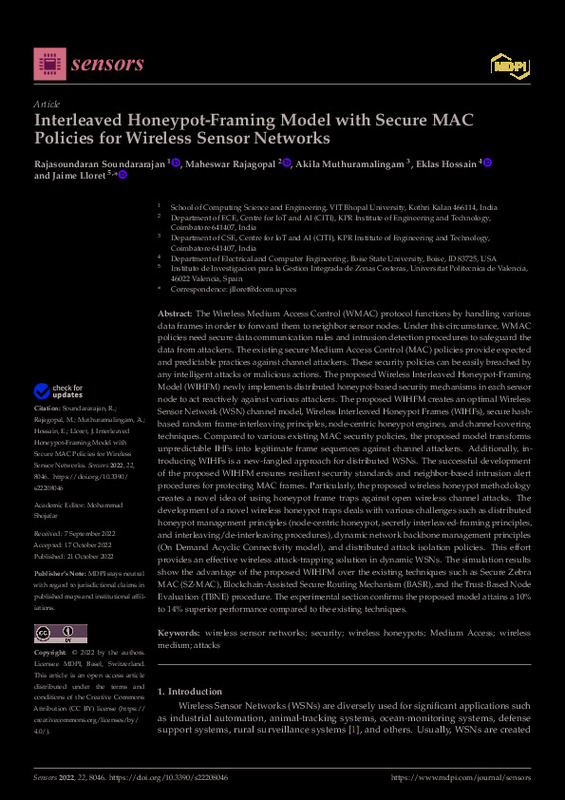JavaScript is disabled for your browser. Some features of this site may not work without it.
Buscar en RiuNet
Listar
Mi cuenta
Estadísticas
Ayuda RiuNet
Admin. UPV
Interleaved Honeypot-Framing Model with Secure MAC Policies for Wireless Sensor Networks
Mostrar el registro sencillo del ítem
Ficheros en el ítem
| dc.contributor.author | Soundararajan, Rajasoundaran
|
es_ES |
| dc.contributor.author | Rajagopal, Maheswar
|
es_ES |
| dc.contributor.author | Muthuramalingam, Akila
|
es_ES |
| dc.contributor.author | Hossain, Eklas
|
es_ES |
| dc.contributor.author | Lloret, Jaime
|
es_ES |
| dc.date.accessioned | 2024-01-26T19:02:18Z | |
| dc.date.available | 2024-01-26T19:02:18Z | |
| dc.date.issued | 2022-10 | es_ES |
| dc.identifier.uri | http://hdl.handle.net/10251/202176 | |
| dc.description.abstract | [EN] The Wireless Medium Access Control (WMAC) protocol functions by handling various data frames in order to forward them to neighbor sensor nodes. Under this circumstance, WMAC policies need secure data communication rules and intrusion detection procedures to safeguard the data from attackers. The existing secure Medium Access Control (MAC) policies provide expected and predictable practices against channel attackers. These security policies can be easily breached by any intelligent attacks or malicious actions. The proposed Wireless Interleaved Honeypot-Framing Model (WIHFM) newly implements distributed honeypot-based security mechanisms in each sensor node to act reactively against various attackers. The proposed WIHFM creates an optimal Wireless Sensor Network (WSN) channel model, Wireless Interleaved Honeypot Frames (WIHFs), secure hash-based random frame-interleaving principles, node-centric honeypot engines, and channel-covering techniques. Compared to various existing MAC security policies, the proposed model transforms unpredictable IHFs into legitimate frame sequences against channel attackers. Additionally, introducing WIHFs is a new-fangled approach for distributed WSNs. The successful development of the proposed WIHFM ensures resilient security standards and neighbor-based intrusion alert procedures for protecting MAC frames. Particularly, the proposed wireless honeypot methodology creates a novel idea of using honeypot frame traps against open wireless channel attacks. The development of a novel wireless honeypot traps deals with various challenges such as distributed honeypot management principles (node-centric honeypot, secretly interleaved-framing principles, and interleaving/de-interleaving procedures), dynamic network backbone management principles (On Demand Acyclic Connectivity model), and distributed attack isolation policies. This effort provides an effective wireless attack-trapping solution in dynamic WSNs. The simulation results show the advantage of the proposed WIHFM over the existing techniques such as Secure Zebra MAC (SZ-MAC), Blockchain-Assisted Secure-Routing Mechanism (BASR), and the Trust-Based Node Evaluation (TBNE) procedure. The experimental section confirms the proposed model attains a 10% to 14% superior performance compared to the existing techniques. | es_ES |
| dc.language | Inglés | es_ES |
| dc.publisher | MDPI AG | es_ES |
| dc.relation.ispartof | Sensors | es_ES |
| dc.rights | Reconocimiento (by) | es_ES |
| dc.subject | Wireless sensor networks | es_ES |
| dc.subject | Security | es_ES |
| dc.subject | Wireless honeypots | es_ES |
| dc.subject | Medium Access | es_ES |
| dc.subject | Wireless medium | es_ES |
| dc.subject | Attacks | es_ES |
| dc.subject.classification | INGENIERÍA TELEMÁTICA | es_ES |
| dc.title | Interleaved Honeypot-Framing Model with Secure MAC Policies for Wireless Sensor Networks | es_ES |
| dc.type | Artículo | es_ES |
| dc.identifier.doi | 10.3390/s22208046 | es_ES |
| dc.rights.accessRights | Abierto | es_ES |
| dc.contributor.affiliation | Universitat Politècnica de València. Escuela Politécnica Superior de Gandia - Escola Politècnica Superior de Gandia | es_ES |
| dc.description.bibliographicCitation | Soundararajan, R.; Rajagopal, M.; Muthuramalingam, A.; Hossain, E.; Lloret, J. (2022). Interleaved Honeypot-Framing Model with Secure MAC Policies for Wireless Sensor Networks. Sensors. 22(20). https://doi.org/10.3390/s22208046 | es_ES |
| dc.description.accrualMethod | S | es_ES |
| dc.relation.publisherversion | https://doi.org/10.3390/s22208046 | es_ES |
| dc.type.version | info:eu-repo/semantics/publishedVersion | es_ES |
| dc.description.volume | 22 | es_ES |
| dc.description.issue | 20 | es_ES |
| dc.identifier.eissn | 1424-8220 | es_ES |
| dc.identifier.pmid | 36298399 | es_ES |
| dc.identifier.pmcid | PMC9609864 | es_ES |
| dc.relation.pasarela | S\506761 | es_ES |








